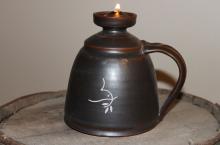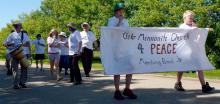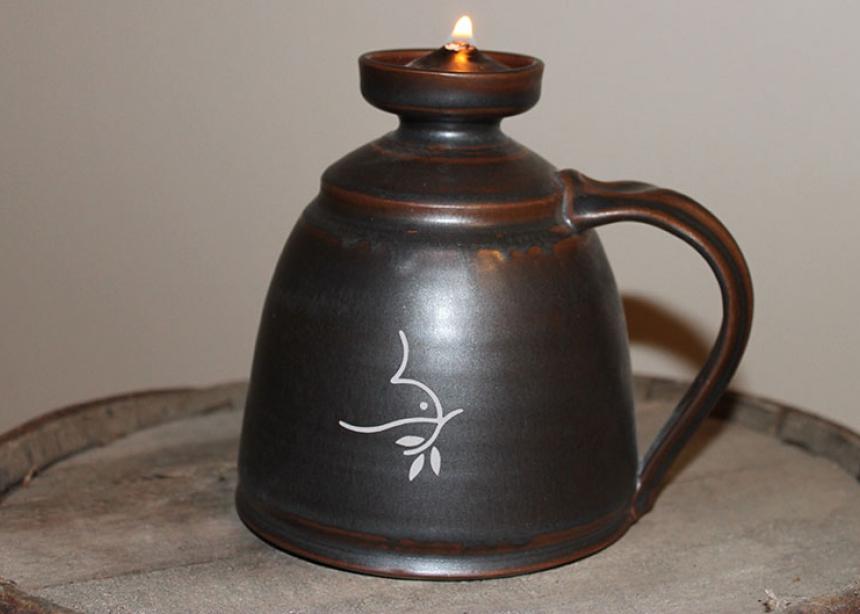“In the last 15 or 20 years, I have heard only one sermon on peace,” says Bernie Loeppky, a member of Grace Mennonite Church in Winkler, Man., and a member of the Evangelical Anabaptist Fellowship (EAF).
Loeppky retells the story of Siegfried Bartel, who grew up in the Mennonite church in Germany between the World Wars. “He was an officer in Hitler’s army,” he recounts. “He always had misgivings about his role in the army, but it was only after he came to Canada and became involved with Mennonite Central Committee [MCC] that he came to a peace position and became a strong advocate for peace.”
Even though Bartel grew up in the Mennonite church, he was never made aware of the peace position before his involvement with MCC, says Loeppky, who recounts this story because of his concern that peace and discipleship have become divorced from the message of salvation.
A strange peace dichotomy
In 2010, Mennonite World Conference (MWC) asked its supporting churches, “How is your church doing in its desire to be a Peace Church?” Gordon Allaby, pastor of Osler Mennonite Church in Saskatchewan, was asked to conduct this peace audit for Mennonite Church Canada. “I found it surprising how many congregations, and even provincial churches, were kind of drifting away from a passion of connecting peace and justice to following Christ, almost as if peacemaking is being relegated or diluted to more humanistic reasoning,” he says.
A few years ago a letter writer to this magazine asked if Jesus was really necessary if world peace could be achieved through human means.
That dichotomy is strongly reflected in some Mennonite congregations.
Plum Coulee Bergthaler Mennonite Church in Manitoba is “definitely moving to a place in the future where ‘Mennonite’ may be dropped from our name because this next generation does not connect to that [peace position] in any way,” says Robert Penner, the church’s youth pastor. “There is a real push for evangelism and bringing the gospel, a desire to have the Spirit and personal peace with God and others, but when it comes to nations, that would be very different.”
Several years ago, the Plum Coulee congregation offered a prayer of blessing over a young person who was joining the military. “We prayed a blessing over him for protection, that he will be the light of Christ wherever he is and that he would use his words and actions to bring reconciliation and peace,” says Penner. “He is the first one [in our congregation] who has joined the military. We have one person who is currently in the process of joining the reserve.”
“Of course, we love peace,” says Artur Esau, pastor of Hague Mennonite Church in Saskatchewan. “The first peace we talk about is the peace between God and man, and that as a consequence of that peace we will make peace with our neighbour. When it comes to wars and rumours of wars, not too much can be done about it. It is not up to us to make peace in the world in the sense of marching for peace. Our good Mennonite brothers and sisters who march for peace around Canada and the U.S. usually do it without Christ. The governments around the world do the same.”
Church efforts to promote peace
“Article 22 of our Confession of Faith [in a Mennonite Perspective] brings into focus the many scriptural imperatives of nonviolent peacebuilding,” says Willard Metzger, executive director for MC Canada. “The governance structures of our national church have not changed their position on peacebuilding in any way. We continue seeking to live into a gospel of peace.”
“In 2008, a congregation brought a resolution to the assembly in Manitoba* to promote more active peacebuilding within our church,” says Dan Dyck, MC Canada’s communications director. “The ‘Live for Peace’ project launched a public education initiative called ‘Peace in the public square,’ which involved creating a website [http://liveforpeace.org] that is still up and offers a challenge to area churches and congregations to raise public awareness. MC Alberta and Saskatchewan were the ones that took it and ran with it. Our role is to resource the congregations and area churches.”
Osler Mennonite was one of the churches that embarked enthusiastically on this campaign. “Our church still is involved in putting ads in the local paper and putting signs along the highway,” says Allaby, but “there has been some waning lately and it is troubling. But our church would still identify itself very much as a Peace Church.”
Robert J. Suderman, former general secretary of MC Canada and now secretary of the MWC Peace Commission, did a cross-country visit of all member congregations during his MC Canada term. “What at first sight appears to be a knee-jerk reaction of the ‘of course, we are a Peace Church’ nature, a second look would reveal a significant impact of ‘just war’ theory, including now the ‘responsibility to protect’ (R2P) doctrine, which both the United Nations and the World Council of Churches are using as a more humane but more compelling justification to violence,” he says. “It is striking to me how the R2P doctrine has become a new way out for almost-pacifists to be pacifists.”
Acculturation—affluence—evangelism
Esther Epp-Tiessen of MCC Canada has worked closely with churches on a peace initiative to build awareness and gather support for tighter legislation regarding cluster munitions. “Within the Anabaptist-Mennonite family, I think MC Canada churches are likely doing more to preach, teach and witness to peace than in some other denominations/conferences,” she says. “However, I think more could be done.”
Epp-Tiessen reports that of the 65 petitions signed by Mennonites regarding cluster munitions, “many of these petitions came from MC Canada congregations.” However, she says she has observed that “there is considerable reluctance to engage in public peace witness. . . . People are reluctant to put themselves ‘out there.’ They prefer a more private peace commitment. Many people express a quiet peace witness by sponsoring refugees, visiting prisoners, living simply. . . . I do not wish to discount this kind of witness, which is very important, but we also have an important message that we should be sharing with the wider world.” I
n his report to MWC about MC Canada’s peace efforts, Allaby writes, “We are a Peace Church and we desire to improve our journey of and to peace. . . . Yet we are of many opinions and perspectives.” One factor that contributes to a waning commitment to peace is affluence, says Allaby. “We are very much ‘in culture’ now. We’re fairly affluent and that has decreased our desire to follow Christ. We’ve got more to risk in speaking out and countering our culture.”
“Many Mennonites are very acculturated in their lifestyle and in their thinking about some of these issues,” says Epp-Tiessen, in agreement with Allaby. “We have become quite comfortable and so it is hard for us to become passionate about engaging in life and death issues. . . . We are reluctant to take risks.”
Loeppky adds the assimilation process as another factor in the church’s drift away from a peace position. He says he finds it “ironic that the local Baptist pastor has chided the Winkler Mennonites for not wanting to be different. They want to be like everyone else.
“Another contributing factor was that following World War II there were some negative experiences with Mennonite young men who came back from the war and their relationship to the church was often troubling,” he says. “There was an overreaction in some churches that resulted in stopping the preaching and teaching [of peace].”
(For more on the issue of how the church reacted to those who opted to serve overseas during the Second World War, read “Let nobody judge them” in the next issue of Canadian Mennonite.)
“Another factor is the influence of the evangelical movement in many churches over the past decade, which focuses just on a personal conversion,” says Allaby. “Some have adopted a two-kingdom approach. There has been a shift in theology that makes it more palatable to go along with the culture and redemptive violence.”
But Allaby, who was drawn to the Mennonite faith because of its peace position, says a peace witness and evangelism cannot be separated. “The peace witness is what it means to be a follower of Christ,” he says. “If we want to take the Great Commission seriously, that is what it means to be part of redemptive salvation. I don’t recall that we have the luxury of picking and choosing what we want to focus on.”
Loeppky, who describes the EAF as an ad hoc group of different Mennonite conferences that exists only in Manitoba today whose mission is to promote the core beliefs of Anabaptism, particularly Christian discipleship, agrees that there is no either/or dichotomy. “The heresy we face today is salvation without discipleship,” he says. “And if you take salvation seriously, you have to take the words of Jesus seriously.”
Inspiring examples but ‘not there yet’
Epp-Tiessen observes many signs of churches passionately living this out today. “I am very inspired by congregations, such as those in Stouffville [Ont.], which are actively witnessing for peace in their community; the Home Street congregation in Winnipeg and the role their youth have played in promoting the Department of Peace initiative; the Grace Mennonite congregation in Prince Albert [Sask.], which is actively promoting reconciliation with indigenous neighbours; [and] the Langley Mennonite Fellowship in B.C., which has for years helped to host an arts and peace festival.”
“Certainly there are many national church programs and ministry examples of our commitment to nonviolent peacebuilding at the national church level,” says Metzger. “Collaboration with the Canadian Council of Churches and the Canadian Department of Peace in political advocacy; international ministry, such as our support of Dann and Joji Pantoja in the peacebuilding work in the Philippines; and our interfaith work, are just a few examples.
”One of the ways to build a stronger peace identity is through education, according to Epp-Tiessen. “People are very much influenced by what they hear in the media, and if the churches do not provide an alternate narrative, that is, a Peace Church narrative, these people will easily be persuaded or convinced by the arguments they hear in the media and in society,” she says.
Canada’s participation in the Afghanistan war offered a telling example of this, she says, noting, “I found many Mennonites reluctant to critique that involvement. Many had accepted the arguments that Canada needed to fight terrorists in Afghanistan and needed to help ‘bring freedom and democracy’ to Afghans. They didn’t have a good way of responding from a pacifist faith perspective to the arguments about Canada being at war. I was struck by how nonchalant a lot of Mennonites were about Canada’s participation.”
EAF’s mandate is to keep this issue front and centre. “Right now, we are doing a series of one-minute Sunday morning broadcasts called ‘Peace Moment’ on three different radio stations in Manitoba,” says Loeppky. “EAF has produced a video series providing an overview of church history with an emphasis on Anabaptists and what they believe, a five-lesson booklet on peace, and a couple of years ago presented 12 ‘Power of Peace’ concerts in Manitoba and Saskatchewan.” For more information, visit the EAF at http://anabaptists.ca.
“I think it is important for Mennonite congregations to emphasize that we are a Peace Church because we have committed our lives to Jesus, the one whose life, death and resurrection reconciles all things, not because peace is an Anabaptist distinctive that we must preserve at all cost,” says Epp-Tiessen. “I think many people, not just Anabaptists, are eager to hear this message.” MCC Canada began to create a Peace Sunday packet for churches across Canada in the 1990s; the 2013 packet is available at http://mcccanada.ca/peace/peacesunday.
Allaby concludes his MC Canada peace audit this way: “Mennonite Church Canada hopes and prays to become the Peace Church the world needs us to be and what God wants us to be. We do not compare ourselves to any other faith journey or organization; our model and inspiration is only Christ as we respond to God’s redemptive love. We are a Peace Church, and our desire for wholeness is strong, yet we know we re not there yet.”
Evelyn Rempel is Canadian Mennonite’s Manitoba correspondent.
Read Gordon Allaby’s 2011 peace audit of Mennonite Church Canada for Mennonite World Conference. [* Corrected to Manitoba from Saskatchewan October 23, 2013]

Arlyn Friesen Epp, director of Mennonite Church Canada’s Resource Centre in Winnipeg, recalls peace lamps being introduced at the 2002 MC Canada assembly in Saskatoon. Congregations were invited to purchase the lamps and pray for peace. Some churches continue to light the peace lamps today.

Osler Mennonite Church photo Osler (Sask.) Mennonite Church took its peace message to the community’s 2012 Canada Day parade. Described as the ‘For Peace Marching Band,’ the group played peace songs on its kazoos, earning a blue ribbon from parade organizers for ‘creativity.’

Mennonite Church Saskatchewan’s Peace and Justice Group developed a bus campaign in conjunction with MC Canada’s ‘Peace in the public square’ initiative in 2010. For two months that year, messages such as the one pictured above were seen on Saskatoon streets.

‘I think it is important for Mennonite congregations to emphasize that we are a Peace Church because we have committed our lives to Jesus . . ., not because peace is an Anabaptist distinctive that we must preserve at all cost.’ (Esther Epp-Tiessen)





Comments
Thank-you, Evelyn, for this helpful overview. I just want to make one small correction. MCC's Peace Sunday Packet was developed first by MCC Ontario in the 1980s. By the late 1990s it was being distributed across the country. Since about 2006, MCC Canada has taken leadership in the production of the Peace Sunday Packet.
Add new comment
Canadian Mennonite invites comments and encourages constructive discussion about our content. Actual full names (first and last) are required. Comments are moderated and may be edited. They will not appear online until approved and will be posted during business hours. Some comments may be reproduced in print.